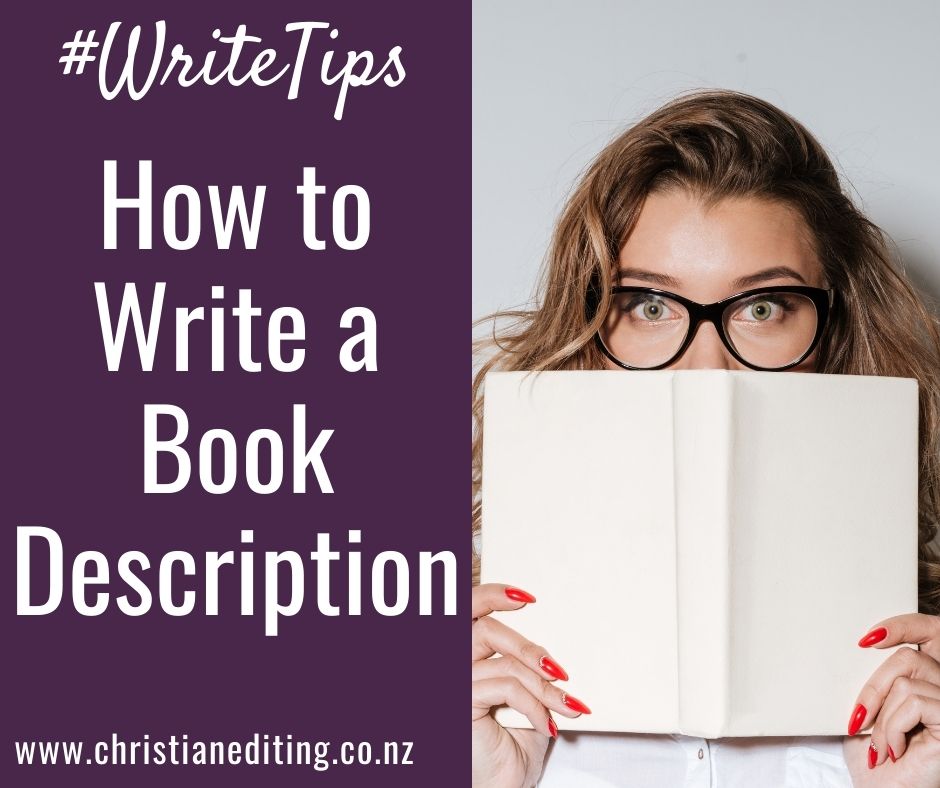It is a truth universally acknowledged that writing a 90,000-word novel is easier than writing 150 words for the back cover. So here are my tips for writing a good book description.
First, let’s clear up some terminology. Authors use several different terms to refer to the back cover copy, and some of these are not technically correct:
Book Blurb
Some authors use “book blurb” to refer to the back cover copy. But publishers often use this term to refer to endorsements: “Will you blurb my book?” So if an author asks you to write them a blurb, make sure you understand which blurb they are looking for.
Synopsis
A synopsis is a summary of the whole book, including the ending. The synopsis is usually one to four pages (so up to 1,000 words), although that will depend on who is asking for it and why (e.g. a contest or a publisher or an agent).
Some people write a one-paragraph version of the synopsis, which is short enough to go on the back of the book (and this may be where the confusion comes from). But a one-paragraph synopsis is still a synopsis in that it summarises the whole story. As such, it’s different from the book description.
Book Description
This is the back cover copy. It’s a sales pitch, second in importance only to the cover.
The potential buyer/reader sees your book on the shelf and is attracted by something about the cover – the title, the cover image or design, or by the author’s name. What do they do next? They usually flip the book and read the back cover. If they’re online, that back cover copy is right next to the cover image.
The purpose of the book description is to hook the reader so they’re interested enough to open the book and check out the writing. If they’re browsing online, they will see the first page (which is why a great opening is so important). If they’re browsing in a physical bookstore, they might check out the opening, but they might also open the book to a random page (which is why the writing needs to be consistently good, with tension on every page).
So the purpose of the back cover copy is to help sell the book. No pressure … which is probably why it’s so hard to write.
How much of the plot should the book description cover?
Ideally, the book description shouldn’t give away too much of the plot. It needs to give away enough to intrigue the target reader, but not so much that the reader is halfway through the book before anything new happens. If the book description references a specific event that kick-starts the action (e.g. a death, a wedding, a new person in town), then those events should occur in the first couple of chapters. Otherwise, readers are likely to skim until they get to the key event which caught their attention.
Writing Your Book Description
Start with Your Logline
A logline is a single sentence that sums up the essences of your plot:
- Introduces the main character and the antagonist.
- Introduces the setting (either specifically e.g. New York, or generally e.g. small-town Ohio).
- Introduces the main character’s story goal.
- Introduces the central conflict.
- May introduce the stakes.
A good logline is 20-30 words (aim for 25).
Yes, writing a logline is hard. But once you’ve got all that information in one sentence, it’s not so hard to expand it to 150 words for your book description.
Let’s try:
- Write one sentence that introduces the main character and their problem or goal, and why they want that (i.e. their motivation).
- If the novel is a romance, write one sentence that introduces the love interest and their problem or goal and their motivation.
- Write one sentence that introduces the antagonist and their goal (and it should be immediately obvious how this is going to cause conflict for the main character and/or the love interest). you may not need this sentence if your novel is purely romance, as the love interest may also be the antagonist.
- Write one sentence about the world this story is set in, and how the setting (in time or place) impacts on the goal or the conflict.
- Write one sentence showing what’s at stake if the main character doesn’t achieve their goal.
You might be able to finish your book description there, or you might need one final sentence to bring the plot together and finish on a bang that convinces the reader to buy.
Just don’t reveal the ending.
Now, edit. Edit, edit, edit. Your book description needs to show your writing to the best possible advantage, so get feedback from author and reader friends.
Here ‘s a checklist for good book description:
- Have you introduced the main character/s?
- Is the genre clear?
- Is the book description written in the same style or voice as the novel? (Although a novel written in first person may use third person for the book description.)
- Does the book description hook the reader (e.g. setting or stakes)?
- Does the book description give away the whole plot? If so, rewrite so it doesn’t.
- Will your target reader want to read the book based on this description?
Finally, proofread and get someone else (or several someones) to check it for you.
You don’t want readers not buying your book because there’s a typo in the book description.

